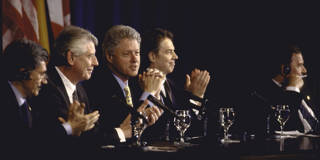OnPoint Subscriber Exclusive
Global Bookmark offers long-form examinations of global trends and challenges, viewed through the lens of important new books.

The Evolution of Modern Political Power
From the rise of large, bureaucratic states in the early twentieth century to the triumph of neoliberalism more recently, shifts in governance models cannot simply be reduced to the natural political instincts of those who find themselves in power at any given moment. There are much larger, and subtler, dynamics at work.
CHICAGO – Where power truly lies is not always clear. In 1998, US President Bill Clinton was certainly among the most powerful people in the world. Having triumphed in the Cold War, the United States had become what French Minister of Foreign Affairs Hubert Védrine called a hyperpuissance – a superpower in terms of both hard and soft power. Notwithstanding the Monica Lewinsky scandal, America’s “New Economy” was roaring, and Clinton was still polling well after his smashing re-election victory in 1996. American-led globalization was on the march, as was representative democracy.